
In the example, we will declare an array of marks(5 subjects) and compute the total marks using a foreach loop.
#For loop java code
1 First, initialization is performed (i0) 2 the check is performed (i < n) 3 the code in the loop is executed. This loop does a one-pass of all the elements in the collection. The way for loop is processed is as follows. *įoreach loop is used to iterate over a Java collection or an array. Let’s look at a simple example that illustrates the usage of the for loop.
#For loop java update
The update part usually contains the loop variable increment/ decrement operation. In a nested for loop, for each iteration of the outer for loop, inner for loop is iterated until the condition in the inner for loop evaluates to false. If the condition is false the loop will be terminated. The key point, which many Java developer doesnt know about the enhanced for loop is that you can use any Object which implements the Iterable interface on for. You can have a for loop (or any other loop) inside another for loop, such loops are known as nested loops. The for loop executes the iteration if the condition is true. So when I enter q (to quit the loop) in an odd position, the program will exit the loop but the only numbers that are read into the ArrayList are the numbers in the even positions. When you reach at 6th object at that time you are accessing l.get (6) at that time IndexOutOfBoundsException throws. Also, your ArrayList contains an integer value. For-Each loop in java uses the iteration variable to iterate over a collection or array of elements. The loop condition is evaluated before each iteration. In your code in for each loop, you get object by index like l.get (i) l is the Arraylist type and it stores the value from 0 index. The For-Each loop is usually used as a substitute for the standard for-statement when a loop counter is not really needed, and every element in the collection. For-Each loop in java is used to iterate through array/collection elements in a sequence. The boolean_condition is the condition that will be checked in each loop iteration. The for loop is an iterative statement which you use to check for certain conditions and then repeatedly execute a block of code as long as those conditions are met.This declares a loop variable i and initializes it to 0. We're only going to look at JavaScript in this article, and we'll look at its syntax and some examples. In other words, loops let your code execute one or more statements as many times as desired.Īgain, there are many types of loops, but we will only look at the for loop in this article.Īlmost every high-level programming language, including JavaScript, has a for loop. Loops are computer programs that execute a set of instructions or a block of code a certain number of times without having to write it again until a certain condition is met.

We now have a dedicated forEach() method in the Iterable interface that accepts a lambda expression representing an action we want to perform.

In this article, we will learn what for loops are, how they work, and why we use them.

And many developers are familiar with loops, but not everyone understands how they work and why or when they should use a specific type of loop. Prerequisite: Decision making in Java For-each is another array traversing technique like for loop, while loop, do-while loop introduced in Java5.

Positive, negative, and zero counter variables are initialized to 0 for. We'll also keep in mind that there are several types of loops, each of which performs a specific function even though they can almost all perform the same common function. Since Java 8, we can leverage for-each loops in a slightly different way. Loops are a programming concept that we constantly encounter and implement as JavaScript developers. It is used in the for loop to define the number of times the loop will iterate. These are the initialization statement, a testing condition, an increment or decrement part for incrementing/decrementing the control variable. For loop in Java Java for loop consists of 3 primary factors which define the loop itself. For syntax Example 1: Write a program in Java to print Hello World five times using for loop Example 2: Write a program in Java to print from 1 to 10 but. In this article, we will learn what for loops are, how they work, and why we use them. In Java there are three primary types of loops:- 1. Loops are a programming concept that we constantly encounter and implement as JavaScript developers.Īnd many developers are familiar with loops, but not everyone understands how they work and why or when they should use a specific type of loop.


 0 kommentar(er)
0 kommentar(er)
